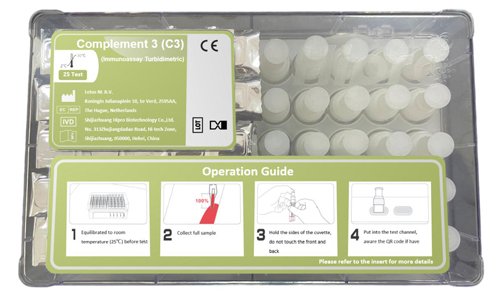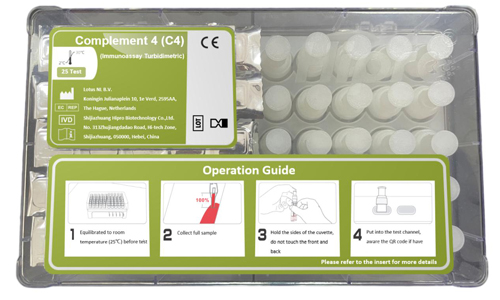C3 is the complement component with the highest content in serum, which is mainly synthesized by macrophages and liver. Under the action of C3 convertase, it is cleaved into 2 fragments: C3a and C3b, which play an important role in both classical complement activation pathway and bypass activation pathway.
Used for in vitro quantitative determination of complement 3 in human serum samples, as an auxiliary diagnostic application.
Principle: A certain amount of complement 3 in human serum meets the corresponding antibody (sheep anti-human complement 3 antibodies) of the reagent in the liquid phase, and combines to form an antigen-antibody complex, resulting in certain turbidity. This turbidity is proportional to the concentration of complement 3 in the sample in the presence of sufficient antibodies. After measuring the turbidity, the concentration of complement 3 in the sample serum can be obtained by comparing it with the standard serum.
Decrease of serum complement 3: seen in acute and chronic glomerulonephritis, systemic lupus erythematosus, and other autoimmune diseases.
Increase of serum complement 3: seen in a variety of inflammation, tumor, with the increase of acute response protein complement synthesis.
Clinical significance of C3 Complement Blood Test: The increase and decrease of C3 were similar to that of total complement activity, but more sensitive. In the body tissue injury and acute inflammation, often increased or normal, such as bacteremia, pneumonia, tonsillitis, tuberculosis, typhoid fever, measles, meningitis, etc. Serum C3 levels increased significantly in tumor patients, especially liver cancer, but decreased in advanced pancreatic cancer and recessive lymphoblastic leukemia.
Clinical significance of Complement 4 Blood Test: During the active stage of the disease, the level of C4 decreased significantly, especially for SLE, which decreased earlier than other complement components and rose later than other components. In both lupus nephritis and non-lupus nephritis, C4 is reduced in the former and normal in most of the latter. In addition, it is also seen in insulin-dependent diabetes mellitus, multiple sclerosis, rheumatoid arthritis, benign recurrent hematuria, IgA nephropathy, Henoch-Schonlein purpura, subacute sclerotic panencephalitis, IgA genetic deficiency, leprosy and other diseases.

